Can You Dry Lights & Darks Together? Can I Mix Colors?
Author: Anne Cowart | Editor: Omar Alonso
Review & Research: Jen Worst & Chris Miller

We all know the laundry hazards of washing lights and darks together in the same load. But what about drying them together? Can you dry lights and darks together? Does this method turn the laundry into a smorgasbord of mixed colors that look terrible, or does it have no effect on clothing, towels, and linens?
Doing laundry isn't the most enthralling of tasks at the best of times, but learning how to do it right makes your clothes last longer. So, can you mix light and dark colors or colors and whites?
Can You Dry Lights & Darks Together?
No. Don't dry lights and darks together if you can avoid doing it, especially if they're new garments, linens, or any types of towels but especially large bath towels. Lights will pick up colors from darker colors, resulting in a change in the color tone. It's easy to make a mistake when drying your clothing, so separating the garments is the best way to ensure you don't get bleeding and cross-coloring when drying.
Usually, clothes that have gone through several wash and dry cycles remove any excess dye in the garments, preventing this problem from happening. However, newer garments should always be washed separately to avoid a cross-color disaster when you open the dryer.
Remember that all clothes you add to the dryer have moisture in them. While the washer uses warm water, the dryer is noticeably hotter. The extra warmth can lead to bleeding and cross-coloration, ruining your wardrobe. There's nothing more upsetting than pulling a new shirt out of the dryer only to see it's a different color than when you put it in.
Sort your clothes before putting them in the dryer. It might take longer and cost you an extra cycle, but it's better than ruining expensive clothing.
Can You Dry Similarly Colored Lights & Darks Together?
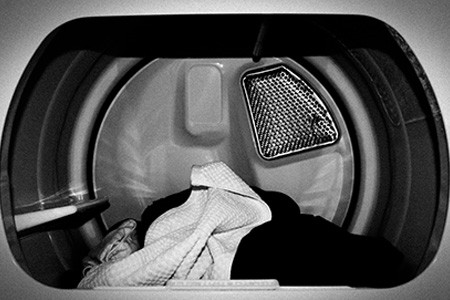
You can dry different colors together as long as they have similar color compositions. For instance, washing reds, oranges, and yellows together aren't much of an issue. However, avoid washing colors on the opposite ends of the color palette.
For instance, don't dry red clothing with blues or blacks. The colors might bleed into each other, especially if you're washing and drying new clothes for the first time. The more separation you get between lights and darks in your loads, the better.
Suppose you don't have enough to fill an entire load. In that case, it's usually fine to dry them together, but avoid adding new clothes to the load and wash and dry them separately or with other clothing of similar colors.
Can You Dry Colors & Whites Together?
Don't dry colors and whites together in the same load. White is like a blank canvas; it can easily pick up colors from other clothing, especially new garments over-dyed by the manufacturer. If even a little dye from a new garment gets into the white fabric, it will change the color and look of the clothes.
You have to treat white garments, towels, and linen with a bit more care in the washer and dryer than you do with other colors. Whites are more susceptible to absorbing stains, so add them in loads with other whites.
If a white garment has other colored prints in it, it shouldn't matter if you wash or dry them with colors or other whites; just make sure you don't do it the first time you wash or dry them to avoid bleeding and staining.
Can You Dry Similar Color Shades Together?
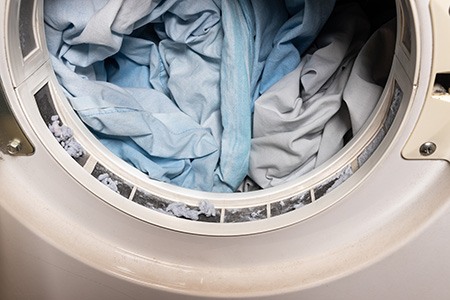
As a rule, don't dry darks and lights together to avoid a laundry disaster. Past that, separate all light colors like yellows, pale greens, pinks, and teals from dark colors like navy, red, brown, and dark green. This practice ensures you don't get any cross-coloration that ruins your clothes.
You shouldn't need to separate colors by color other than dark and light, except maybe while being careful for the first (or even two times) of washing and drying new articles of clothing.
While white is the most sensitive color to bleeding and cross-coloration, light colors like yellow and pales are also at risk of experiencing this problem. So, separate them in the wash and keep your wardrobe safe from ruin.
Colors like sky blue, salmon, and pastels will eventually lose their hue when dried alongside darker colors like black, navy, and red. Sort your clothing and prevent cross-coloration. While you have to contend with more cycles and higher electricity costs, just one cross-colored load costs more than running hundreds of additional cycles.
Can you dry lights and darks together? The main rule to remember is no on that, even for similarly colored shades, like dark blue and light blue. You can still get bleeding that will ruin the light clothing.
Do Colors Run in Warm Water?
We don't recommend washing or drying colored clothing with whites or light colors to avoid cross-coloration from bleeding. However, the biggest tip we can give you is to avoid washing or drying new clothing with other colors – keep it to the same palette. As mentioned, manufacturers sometime over-dye their products in production.
That isn't always the case with all clothing brands, but if you're washing and drying handmade clothing, there's a good chance the colors will bleed and cause cross-coloration. We recommend washing and drying a new garment separately or with other similar colors at least two or three times before adding it to mixed loads in the dryer or washer.
The only exception is white clothing. It doesn't have any pigment that might run. Suppose you're washing and drying new garments for the first time. In that case, it might be a good idea to handwash them and dry them on the line to allow the colors to set before adding them to the washer and dryer on the second or third cycle.
Suppose you can't wash by hand and dry on the line. In that case, we recommend going for a cold wash and drying the clothing separately on the first pass to avoid a huge disappointment.
Can You Dry Clothes & Towels Together?
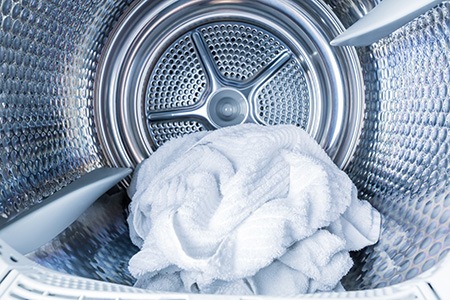
We recommend avoiding drying towels and clothing, like skirts or t-shirts, together. Towels feature design and manufacture with thicker, denser materials than garments. As a result, they need a longer time in the dryer, and your clothing may shrink or come out wrinkled. You can wring out and hang your towels to dry if you choose, or dry them separately later.
Separating towels, linens, and clothing is always a good idea before tossing them in the dryer. Also, it's important to consider that drying your clothing and towels together increases the load's lint. That lint will likely stick to your clothing.
Keep your clothing lint-free; don't mix them with towels and linen in the dryer. It might save you a few minutes to dry them together, but the hassle of rewashing and drying everything because of lint contamination isn't worth the risk.
Drying towels and clothing together means the dryer has to work longer to dry everything. So, if you're drying a new garment, the additional heat might cause it to shrink. There's also a good chance that the clothes come out overly wrinkled, causing you to spend more time ironing your laundry.
Can You Dry Bleached Clothes with Darks or Colors?
Never dry bleached clothes with colors or darks in the dryer. We can't stress this enough, don't make this mistake. Bleach is a powerful cleaning agent, and it's great for getting stains out of white clothing or sprucing whites up after several years of use.
However, the bleach will remain in the wet clothing, spreading throughout the dryer to your other garments during the drying cycle. The result is all your colors and darks come out with bleach spots, a lighter shade than when you put them in, or you'll find the colors bleed together.
Dry bleached clothing separately. If you want to use bleach in the laundry, we recommend using a stain remover instead. While bleach is effective at removing stains, it's also a caustic cleaning agent and may damage sensitive fabrics. Be careful if you make your own laundry detergent substitutes, too. Make sure if they feature bleach as an ingredient or not.
What is Considered White & Dark Colors in Laundry?
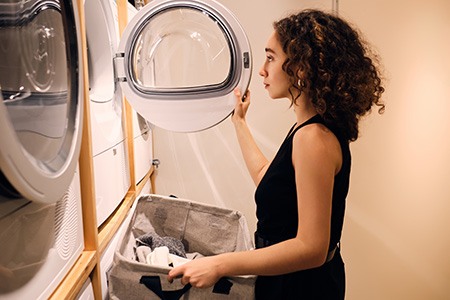
Can you dry lights and darks together? No, but what good is that answer if you don't know what constitutes a light or a dark. It's essential you separate your clothing according to color if you want the best results when drying your garments. Drying everything together can result in a laundry disaster that ruins your wardrobe.
Dark colors include red, navy, black, dark purple, and darker shades of blues and greens. Whites are only suitable for washing and drying with other whites. Some whites might have colored prints; you can dry them with other colors.
Here's a quick guide on identifying each color type and what goes with what is in the dryer:
- Light colors include light blue, light purple, light green, lavender, teal, periwinkle, yellow, powder or sky blue, and pastels.
- Dark colors include black, orange, red, dark purple, burgundy, navy, brown, and other darker colors.
- White colors are white or dominantly white. An example would be white socks with yellow threads across the toe line.
The only exception is clothing with other color prints, which you can dry with different colors, provided the other clothing and the white/mixed garment isn't new. If they're new, wash and dry them alone for the first few loads.
Denim in any color should be considered a color or a dark, depending on the hue of blue in the jeans. Jeans can often be over-dyed, so keep them in a separate load for the first few laundry cycles to prevent bleeding and cross-coloration with the rest of your laundry. Considering the weight of the jeans, you can dry them with your towels for the best results. Jeans have a different process for washing, especially the first time.
Key Takeaways Regarding Drying Lights & Darks Together
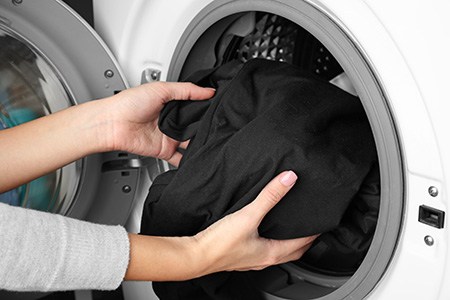
Here’s a quick summary you can follow to make sure you don’t experience the dreaded color bleeding while drying your laundry.
- Don't mix colors in the dryer.
- Don't mix lights with darks or colors with whites.
- Don't mix bleached clothing with other clothing in the dryer.
- Don't dry towels and clothes in the same loads.
- Properly sort your laundry before drying to improve the longevity of your clothing and reduce the risk of laundry disasters.
This is the best way to maintain the color fastness and quality of your clothing, but to be honest, if you’re wearing clothes that are years old and have been washed dozens of times, you’re not going to risk color bleeding issues. However, still never combined bleached whites with colors of any kind in the washer or dryer.
So Can You Dry Dark & Light Clothes Together?
To recap, you should be in the practice of never doing this because you’ll be mixing new and old clothes in the same batches of laundry, and it’s the new clothes that bleed color. If your entire wardrobe is old and has been washed dozens of times, you’re at very little risk of this happening though. But it’s better to just set the ground rule: can you dry lights and darks together? Just say no and you won’t have any issues.




